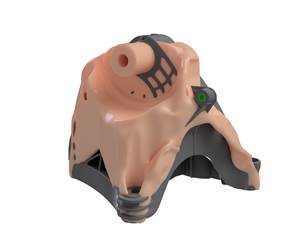Self-Reinforced Composite Based on PLA Fibers Wins 2019 Global Bioplastics Award
The Bio4Self (16 partner companies from the European Union) won the 14th Global Bioplastics Award.
Biobased and easy-to-recycle self-reinforced composites based on PLA fibers with an inherent high stiffness, which are being developed within the framework of the Bio4self project funded by the European Research Fund H2020, open up completely new fields of application for PLA. The progress to date and the promise of future developments impressed the judges of this year’s Global Bioplastic competition to award first prize to Bio4self. The prize was awarded by the trade journal Bioplastics magazine to the winning consortium, represented by Belgium’s Centexbel, on Dec. 3, 2019 during the 14th European Bioplastics Conference in Berlin, Germany.
An international consortium with the participation of Centexbel, Germany’s Fraunhofer ICT, Germany’s Institute of Textile Technology of the RWTH Aachen and 13 other partners, has developed a self-reinforced composite of PLA. In the Bio4Self project, two different PLA grades are required to produce self-reinforced polymer composites or SRPCs: a low melting temperature PLA grade to form the matrix and an ultra-high stiffness and high melting temperature PLA grade to form the reinforcing fibers.
Bio4self innovations have been shown to overcome several challenges related to the production of PLA SRPC:
▪ Formulation of a moisture/humidity-resistant PLA grade.
▪ Melt extrusion of ultra-high stiffness PLA reinforcement fibers.
▪ Development of (consolidation and thermoforming) manufacturing procedures to produce the highest performance SRPC material.
▪ Industrial scale up of production.
Self-reinforced PLA composites made of 0/90 fabric have a stiffness of 4 GPa/580,150 psi, which is comparable to the stiffness achieved by self-reinforced PP, but the PLA SRPC has the advantage of using renewable materials with a better end-of- life perspective.
These composites are designed for high mechanical strength and rigidity as well as high temperature and hydrolytic stability. In addition, such a composite is fully biobased, easily recyclable, formable and industrially biodegradable. As a result, PLA is being upgraded to a material suited for more technical and demanding final applications including automotive and household electronics, and offers possibilities for lots of other applications (sports, transportation, and medical appliances). As the first prototypical applications of the material, the partners presented a hybrid seating structure.
PLA materials are based on renewable resources, so-called lactic acids, which can be obtained from agricultural waste or specially cultivated raw materials such as sugar cane. Although the composite materials developed have been functionalized for high mechanical strength and stiffness as well as for high temperature and hydrolysis stability, like pure PLA they are completely biobased, recyclable, formable and even industrially biodegradable. These industrial-scale composites represent a milestone in the development of functionalized, mechanically high-strength, biobased material systems. Furthermore, the development makes a significant contribution to the recycling economy.
As an example, the application in a car seat structure was demonstrated at the JEC Composite trade show in March 2019. During the show, this project was awarded a JEC Innovation Award for sustainability, announced at the JEC Innovation Award ceremony on March.
During the recent Global Bioplastics Award ceremony, which honored this same application, Michael Thielen, publisher of Bioplastics magazine, noted, "It shows, that the intelligent combination of different forms of the same versatile bioplastic material PLA can lead to sophisticated solutions that enable the use for much more than just packaging applications." Even if the benefit of being biodegradable does not reveal itself at first glance, the whole concept can serve as a good example of what is possible with bioplastics.
The second prize went to Germany’s Nölle Kunststofftechnik and Fraunhofer IAP for their new splint for bone fractures. The novel splint made of PLA for immobilizing bone fractures can be repeatedly reshaped during treatment, such as, for example, when the swelling subsides. This is yet another sophisticated example for innovative applications with PLA.
The third prize went to France’s Carbiolice for their Carbiolice
enzymatic masterbatch to make PLA home compostable. The new masterbatch reportedly accelerates the natural PLA biodegradation process, making it suitable for home composting.
Related Content
LFT-D Thrives in Automotive and Other Durables
Teijin Automotive acquires its 10th direct long-fiber thermoplastic system as demand for this technology soars.
Read MoreImpacts of Auto’s Switch to Sustainability
Of all the trends you'll see at NPE2024, this one is BIG. Not only is the auto industry transitioning to electrification but there are concerted efforts to modify the materials used, especially polymers, for interior applications.
Read MoreCelanese to ‘Shine’ at CES 2023 with Expanded Portfolio of Materials
With it acquisition of DuPont’s engineering resins, Celanese’s resin solutions for automotive electrification, e-mobility and consumer electronics are plentiful.
Read MoreDesign Optimization Software Finds Weight-Saving Solutions Outside the Traditional Realm
Resin supplier Celanese turned to startup Rafinex and its Möbius software to optimize the design for an engine bracket, ultimately reducing weight by 25% while maintaining mechanical performance and function.
Read MoreRead Next
How Polymer Melts in Single-Screw Extruders
Understanding how polymer melts in a single-screw extruder could help you optimize your screw design to eliminate defect-causing solid polymer fragments.
Read MoreWhy (and What) You Need to Dry
Other than polyolefins, almost every other polymer exhibits some level of polarity and therefore can absorb a certain amount of moisture from the atmosphere. Here’s a look at some of these materials, and what needs to be done to dry them.
Read MoreUnderstanding Melting in Single-Screw Extruders
You can better visualize the melting process by “flipping” the observation point so that the barrel appears to be turning clockwise around a stationary screw.
Read More








.png;maxWidth=300;quality=90)

















